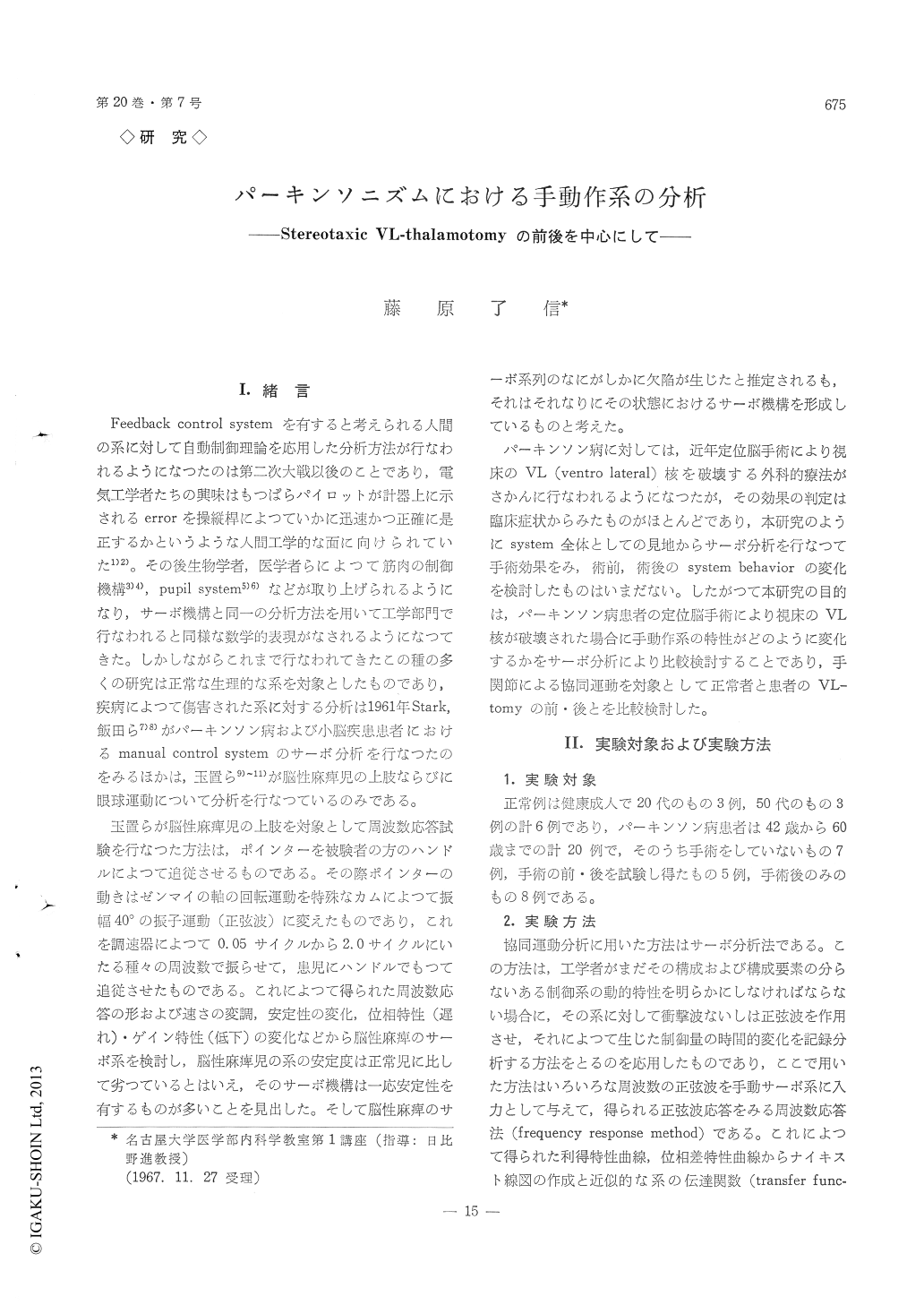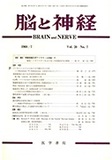Japanese
English
- 有料閲覧
- Abstract 文献概要
- 1ページ目 Look Inside
I.緒言
Feedback control systemを有すると考えられる人間の系に対して自動制御理論を応用した分析方法が行なわれるようになつたのは第二次大戦以後のことであり,電気工学者たちの興味はもつぱらパイロットが計器上に示されるerrorを操縦桿によつていかに迅速かつ正確に是正するかというような人間工学的な面に向けられていた1)2)。その後生物学者,医学者らによつて筋肉の制御機構3)4), pupil system5)6)などが取り上げられるようになり,サーボ機構と同一の分析方法を用いて工学部門で行なわれると同様な数学的表現がなされるようになつてきた。しかしながらこれまで行なわれてきたこの種の多くの研究は正常な生理的な系を対象としたものであり,疾病によつて傷害された系に対する分析は1961年Stark,飯田ら7)8)がパーキンソン病および小脳疾患患者におけるmanual control systemのサーボ分析を行なつたのをみるほかは,玉置ら9)〜11)が脳性麻痺児の上肢ならびに眼球運動について分析を行なつているのみである。
玉置らが脳性麻痺児の上肢を対象として周波数応答試験を行なつた方法は,ポインターを被験者の方のハンドルによつて追従させるものである。その際ポインターの動きはゼンマイの軸の回転運動を特殊なカムによつて振幅40°の振子運動(正弦波)に変えたものであり,これを調速器によつて0.05サイクルから2.0サイクルにいたる種々の周波数で振らせて,患児にハンドルでもつて追従させたものである。これによつて得られた周波数応答の形および速さの変調,安定性の変化,位相特性(遅れ)・ゲイン特性(低下)の変化などから脳性麻痺のサーボ系を検討し,脳性麻痺児の系の安定度は正常児に比して劣つているとはいえ,そのサーボ機構は一応安定性を有するものが多いことを見出した。そして脳性麻痺のサーボ系列のなにがしかに欠陥が生じたと推定されるも,それはそれなりにその状態におけるサーボ機構を形成しているものと考えた。
For analysing a manual control system, a servo-analytic method was taken. The motor coordination apparatus consist of pointer, handle with potentio-meter and recorder. Watching the pointer moved by complex unpredictable input, mixed three sinusoids, the examinee followed it with the handle carefully. Frequency ratio of three low frequency sinusoids utilized for excluding man's predictability was about 4 : 2 : 1 and ratio of amplitude was 1 : 2 : 4. Total amplitude was ±21 degrees.
Thirteen combinations of three sinusoids, with cen-tral frequency ranged between 0. 04 cps and 4 cps with linear relationship, were assorted at random fashion.
A sinusoid with central frequency in the un-predictable input and a component of the same fre-quency filtered from total output through a band pass filter, were picked up and compared with each other. Both gain and phase difference in the cen-tral frequency were calculated, from which data gain curve, phase difference curve and Nyquist diagram were plotted.
As experimental material 6 normal subjects, 20 parkinsonian subjects (7 cases before thalamotomy, 5 cases before and after and 8 cases after thala-motomy) were observed. On the gain curve of par-kinsonian subjects, the severer the disease, the less prominent the resonances which were appeared in normal subjects, the gain diminishes and the break-ing frequency becomes down, in comprison to nor-mal subjects' one.
By thalamotomy on moderate case, the resonances on the gain curve begin to recover, the gains in-crease to be near the normal values and the higher frequencies than preoperative one are able to be fol-lowed by the postoperative patients. On severe cases, the effect of thalamotomy still remains in the same grade of non-operative mild or moderate case. The gain curve several years after operation, shows di-minution of resonances again.
One of the reasons why normal and parkinsonian subjects have the same resonant frequencies seems to be the physical characteristics of arm, such as el-asticity, viscosity, inertia etc.
Each of phase difference curve shows gradually increasing lag in the response of the higher fre-quency, whose tendency is shown more prominent in severe cases. On the moderate case, however, phase lag between 0.2 cps and 0.5 cps is somewhat prominent but this recovers by VL tomy, coming near normal curve. This fact may be due partly to disappearance of its tremor.
Each of Nyquist diagram does not encircle a crit-ical point (-1+jo), expressing stability, but the Nyquist diagram of parkinsonian subjects shows that their stable response range is narrower than that of normal subjects.
Thalamotomy spreads the stable range and in-creases the speed of reaction near to normal range in terms of servomechanism.

Copyright © 1968, Igaku-Shoin Ltd. All rights reserved.


